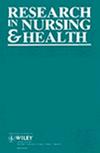脊柱裂青少年的自我管理和独立性轨迹:与家庭相关的成长预测因素
IF 2.1
4区 医学
Q2 NURSING
引用次数: 0
摘要
本研究旨在评估脊柱裂(SB)青少年自我管理轨迹的家庭相关预测因素。脊柱裂患者在四个时间点完成了青少年自我管理和独立量表(AMIS II)访谈。家庭功能、与家庭相关的压力和感知到的家庭支持由多个报告人和多种方法进行评估。在控制了社会人口学、病情相关变量和神经心理学变量(这些变量在之前的研究中被认为是自我管理的重要预测因素)后,使用线性混合效应模型估算了 AMIS II 自我管理总分量表和 AMIS II 分量表(病情和独立生活)的增长情况,并将其作为家庭因素的函数。采用阿凯克信息准则(AIC)对模型的拟合度和简约性进行了评估。这个多样化的社区样本包括 99 名 18-27 岁的受访者。约半数为女性(52.5%)和白人(52.5%);15.2%为黑人,32.3%为西班牙裔/拉丁裔。基线观察到的家庭凝聚力与 18 岁时的所有自我管理量表相关(所有 p 均为 0.05)。自我管理能力的增长与家长报告的家庭压力事件数量有关。对于总自我管理能力的增长,最佳模型包括年龄、种族/民族、家庭收入、分流状态、病变程度、神经心理功能、观察到的家庭凝聚力以及年龄与家庭压力事件数量的交互效应。研究结果表明,即使在控制了社会人口学、病情相关和神经心理学协变量后,家庭因素仍是自我管理轨迹的重要预测因素。在患有SB的青少年家庭中发现的风险和保护因素可以为以家庭为中心的自我管理干预提供参考。本文章由计算机程序翻译,如有差异,请以英文原文为准。
Trajectories of self‐management and independence in youth with spina bifida: Family‐related predictors of growth
The purpose of this study was to assess family‐related predictors of self‐management trajectories in youth with spina bifida (SB). Participants with SB completed the Adolescent/Young Adult Self‐Management and Independence Scale (AMIS II) interview across four time points. Family functioning, family‐related stress, and perceived family support were assessed by multiple reporters and multiple methods. Growth in AMIS II total self‐management and the AMIS II subscales (Condition and Independent Living) were estimated using linear mixed effect models as a function of family factors, after controlling for socio‐demographic, condition‐related, and neuropsychological variables that had been found to be significant predictors of self‐management in prior studies. Model fit and parsimony were assessed using Akaike's information criterion (AIC). This diverse community sample included 99 respondents aged 18–27 years old. About half were female (52.5%) and White (52.5%); 15.2% were Black, and 32.3% were Hispanic/Latino. Observed family cohesion at baseline was associated with all self‐management scales at age 18 (all p < 0.05). Growth in self‐management was associated with parent‐reported number of family stress events. For growth in total self‐management, the best model included age, race/ethnicity, family income, shunt status, lesion level, neuropsychological function, observed family cohesion, and an age‐by‐number of family stress events interaction effect. The study findings suggested that family factors were important predictors of self‐management trajectories, even after controlling for socio‐demographic, condition‐related, and neuropsychological covariates. Risk and protective factors identified in families of youth with SB can inform family‐focused interventions for self‐management.
求助全文
通过发布文献求助,成功后即可免费获取论文全文。
去求助
来源期刊
CiteScore
3.90
自引率
0.00%
发文量
73
审稿时长
6-12 weeks
期刊介绍:
Research in Nursing & Health ( RINAH ) is a peer-reviewed general research journal devoted to publication of a wide range of research that will inform the practice of nursing and other health disciplines. The editors invite reports of research describing problems and testing interventions related to health phenomena, health care and self-care, clinical organization and administration; and the testing of research findings in practice. Research protocols are considered if funded in a peer-reviewed process by an agency external to the authors’ home institution and if the work is in progress. Papers on research methods and techniques are appropriate if they go beyond what is already generally available in the literature and include description of successful use of the method. Theory papers are accepted if each proposition is supported by research evidence. Systematic reviews of the literature are reviewed if PRISMA guidelines are followed. Letters to the editor commenting on published articles are welcome.

 求助内容:
求助内容: 应助结果提醒方式:
应助结果提醒方式:


